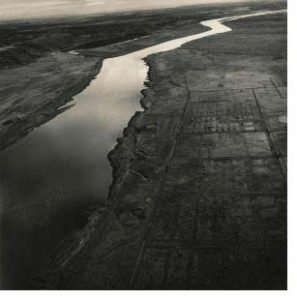
![]() In 1986, while in the sixth year of photographing the aftermath of the Mount St. Helen’s volcanic eruption in the state of Washington, Emmet Gowin made a side trip to photograph the nearby Hanford Nuclear Reservation. Recently described as “the biggest, most toxic waste site in the Western hemisphere,” the Hanford facilities were created in 1943 to produce plutonium for the Manhattan Project.[footnote]Ken Boddle, “6 reasons to know about Hanford’s nuclear waste,” http://koin.com/2014/04/24/6-things-know-hanfords-nuclear-waste//. Accessed Dec. 12, 2016.[/footnote] In operation from World War II through the Cold War, nine nuclear reactors were built along the Columbia River where approximately 475 billion gallons of contaminated water were released into the soil. Although efforts to clean up 56 million gallons of radioactive waste have been underway since the 1980s, underground storage tanks are leaking into the soil with the potential for serious environmental consequences.
In 1986, while in the sixth year of photographing the aftermath of the Mount St. Helen’s volcanic eruption in the state of Washington, Emmet Gowin made a side trip to photograph the nearby Hanford Nuclear Reservation. Recently described as “the biggest, most toxic waste site in the Western hemisphere,” the Hanford facilities were created in 1943 to produce plutonium for the Manhattan Project.[footnote]Ken Boddle, “6 reasons to know about Hanford’s nuclear waste,” http://koin.com/2014/04/24/6-things-know-hanfords-nuclear-waste//. Accessed Dec. 12, 2016.[/footnote] In operation from World War II through the Cold War, nine nuclear reactors were built along the Columbia River where approximately 475 billion gallons of contaminated water were released into the soil. Although efforts to clean up 56 million gallons of radioactive waste have been underway since the 1980s, underground storage tanks are leaking into the soil with the potential for serious environmental consequences.
In Gowin’s aerial photograph, Old Hanford City Site and the Columbia River, Hanford Nuclear Reservation, near Richland, Washington, the staggering scale of the environmental abuse at Hanford is not immediately apparent. A radiant river winds through a stark landscape to a hazy horizon in what appears to be a continuation of the nineteenth-century tradition visualizing ethereal moments in majestic nature. However, upon knowing the more about the location and its place in twentieth-century environmental history, that glowing river winding through a radioactive landscape becomes ominously menacing.
Although Gowin first achieved prominence on the basis of his portrait and figural work, his photographs of Mount St. Helen’s, the Hanford nuclear reservation, as well as aerial photographs of the effects of nuclear testing at the Nevada Test Site have given Gowin an important place among photographers who record places scarred by human or natural devastation. As poet Terry Tempest Williams has observed, “Emmet Gowin has captured on film the state of our creation and conversely, the beauty of our losses.”[footnote]Terry Tempest Williams, Emmet Gowin: Changing the Earth (New Haven: Yale University Press, 2002), p. 131.[/footnote]

After dismantlement, the nuclear reactor from the Trojan Nuclear Plant, photographed in 1982 by John Pfahl, was enclosed in concrete foam, sheathed in blue shrink-wrapped plastic, and taken by barge to the Hanford Nuclear Reservation where it was buried in a forty-five-foot deep pit and covered with gravel.